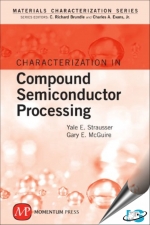Tab Article
Compound semiconductors such as Gallium Arsenide, Gallium Aluminum Arsenide, and Indium Phosphide are often difficult to characterize and present a variety of challenges from substrate preparation, to epitaxial growth to dielectric film deposition to dopant introduction.
This book reviews the common classes of compound semiconductors, their physical, optical and electrical properties and the various types of methods used for characterizing them when analyzing for defects and application problems.
The book features:
- Characterization of III-V Thin Films for Electronic and Optical applications
- Characterization of Dielectric Insulating Film layers
- A Special case study on Deep Level Transient Spectroscopy on GaAs
- Concise summaries of major characterization technologies for compound semiconductor materials, including Auger Electron Spectroscopy, Ballistic Electron Emission Microscopy, Energy-Dispersive X-Ray Spectroscopy, Neutron Activation Analysis and Raman Spectroscopy


